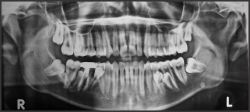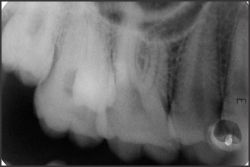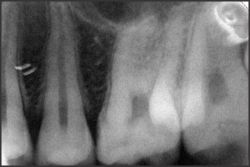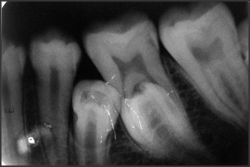Introduction
Supernumerary teeth are present in addition to the normal complement of teeth in permanent / deciduous dentitions.[1] These teeth may closely resemble the teeth of the group to which it belongs, i.e. molars, premolars or anterior teeth, or it may bear little resemblance in size or shape to which it is associated.
The incidence of supernumerary teeth is high in permanent dentition, affecting both the sexes, more common in males, with the male to female ratio of 2:1[2] and with a frequency of 0.14% - 0.64% of the general population.[3] Supernumerary teeth can occur as singles, multiples, unilateral or bilateral, and in the maxilla, mandible or both. Supernumerary teeth are estimated to occur in the maxilla 8.2 to 10 times as frequently as in the mandible and most commonly affect the premaxilla.[2] Supplemental premolars constitute approximately 10% of the total supernumerary cases, and almost 75% of those are present in the mandible.[4]
Supernumeraries generally cause problems of malocclusion of local nature like tipping of adjacent teeth, rotation, bodily displacement, delayed eruption or prevent eruption of tooth of normal series. They lead to esthetic disharmony, functional distortion and may also cause formation of follicular cysts with significant bone destruction and root resorption of the permanent teeth.[5]
Such multiple supernumerary teeth are usually associated with developmental disorders or syndromes like cleidocranial dysplasia and Gardner's syndrome.[6] Occurrence of multiple supernumerary teeth in the absence of any associated syndrome or condition is very uncommon.
Case Report
A 22-year old male patient reported to dental clinic with the chief complaint of pain in the right lower back tooth region since 4 days. Patient gave the history of pain which was intermittent, mild in nature, increased after taking food, localized to the distal of lower right second molar, and got relieved on medication. Pain was not associated with any other symptom.
On clinical examination patient showed bilateral absence of 3rd molars in both the jaws with 28 teeth completely erupted in the oral cavity. It was also observed that patient had 3 partially erupted supernumerary teeth in the oral cavity, one tooth each erupting palatally i.r.t 16-17 and 26-27 (Figure 1) and one tooth erupting lingually i.r.t 46-47 (Figure 2).
The area of chief complaint and the areas of teeth eruption were in different regions of the oral cavity, patient was advised for a orthopantomogram (OPG). The OPG
 | Figure 1: Palatally erupted supermumerary teeth between 16-17 and 26-27.
 |
 | Figure 2: Lingually erupted supermumerary tooth between 46-47.
 |
showed a total of 39 teeth in both the jaws (Figure 3). It was noted that all the quadrants had impacted 3rd molars. It was also observed that the patient had a total of seven supernumerary teeth, five of which were in the mandible and two in the maxilla.
As the OPG showed only faint images of the supernumerary teeth, intraoral periapical radiographs (IOPA) were taken to confirm the findings of the OPG in all the regions. IOPA i.r.t 14-18 showed presence of one supernumerary tooth between 16-17 (Figure 4). IOPA i.r.t 24-27 showed presence of one supernumerary tooth between 26-27 (Figure 5). IOPA i.r.t 34-37 showed presence of two supernumerary teeth one in between 35-36 and the other overlapping the roots of 36 (Figure 6). IOPA i.r.t 45-48 showed presence of three supernumerary teeth between 45-46 and 46-47 and distally inclined to 47 (Figure 7). All supernumerary teeth, both impacted and partially erupted in oral cavity, resembled premolars in shape and size. Patient was examined for presence of any other associated dental, skeletal or medical condition.
Based on the dental findings and the absence of any associated disorder, the case was diagnosed as non-syndromic multiple supernumerary teeth and the patient was informed of the diagnosis.
Discussion
Supernumerary teeth may occur with or without more than 20 syndromes and developmental conditions, however, non-syndromic multiple supernumerary teeth are rarely encountered.[7]
The etiology of supernumerary teeth is not known, but several hypotheses have been proposed[8]:
1. Disruption of normal embryonic processes.
a. Epithelial cell remnants
b. Dichotomy of tooth germs.
c. Proliferation of dental lamina.
2. Progress zone of dental lamina at the end of every tooth series or class gives rise to supernumerary teeth.
3. Atavism - This theory states that supernumeraries are a return to primitive dentition.
4. Hereditary - While an autosomal dominant inheritance is suggested, there is an increased incidence in male to female ratio indicating the possibility of sex - linked hereditary.
 | Figure 3: Orthopantomogram.
 |
 | Figure 4: IOPA Radiograph i.r.t.14-18.
 |
 | Figure 5: IOPA Radiograph i.r.t.24-27.
 |
 | Figure 6: IOPA Radiograph i.r.t.34-37.
 |
 | Figure 7: IOPA Radiograph i.r.t.45-48.
 |
5. Mutant genes can also account for supernumeraries.
Many complications can be associated with supernumeraries, like impaction, delayed eruption or ectopic eruption of adjacent normal teeth, crowding, development of median diastema and formation of follicular cysts around supernumerary teeth with significant bone destruction, root resorption, pulp necrosis, pulp canal obliteration and ankylosis of the permanent teeth.[5]
Supernumerary teeth are classified based on their morphology and location in the dental arch. In the presented case, six of the seven supernumerary teeth seen in the radiographs were in the premolar region. Supernumerary premolars are usually asymptomatic and most cases are diagnosed coincidentally during inspection of radiographs prior to the commencement of ortho-dontic treatment.[9], [10]
The primary step of management is the localization and identification of the complication associated with supernumeraries. Routine checkup should be scheduled for a supernumerary tooth. The need for surgical extraction does not arise till the tooth erupts spontaneously, without any signs of complications. However, surgical intervention should be considered if there are signs of complications, such as cystic changes, root resorption, or eruption disturbance of adjacent teeth. Treatment depends on the type and position of the supernumerary tooth and its effects on the adjacent tissues.
In this case the chief complaint of the patient was treated by extraction of the impacted third molar in the fourth quadrant. Interestingly during extraction, the socket did not reveal the supernumerary tooth seen in the OPG and IOPA i.r.t 47-48. So the treatment for the supernumerary teeth was planned to be done at a later stage which included extraction of partially erupted three supernumerary teeth and observation for rest of the five impacted supernumerary teeth. Hence it was decided to follow up the presented case with regular visits and radiographs to check for the development of any complications.
Conclusion
Early diagnosis and treatment of patients with supernumerary teeth are important to prevent or minimize complications. Routine checkup should be scheduled for a supernumerary tooth. The need for surgical extraction does not arise till the tooth erupts spontaneously, without any signs of complications. However, surgical intervention should be considered if there are signs of complications, such as cystic changes, root resorption, or eruption disturbance of adjacent teeth. Treatment depends on the type and position of the supernumerary tooth and its effects on the adjacent tissues.
References
1. Shafer WG. Developmental disturbance in shape of teeth in Shafer W.G, Hine M.K, Levy B.M.: A textbook of oral pathology, 4th ed. W. B. Sunders: Tokyo; 1983. p. 42-4.
2. Rajab LD, Hamdan MA. Supernumerary teeth: review of the literature and a survey of 152 cases. Int J Paediatr Dent. 2002 Jul;12(4):244-54.
3. Piattelli M, Piattelli A. Multiple impacted and erupted supernumerary premolars. Acta Stomatol Belg. 1995 Jun;92(2):75-6
4. Stafne EC: Supernumerary teeth. Dent Cosmos 74:653, 1932.
5. Hattab FN, Yassin OM, Rawashdeh MA. Supernumerary teeth: Report of three cases and review of the literature. J Dent Child 1994;61:382-93.
6. Hong-Keun Hyun, Byung-Duk Ahn, Min-Suk Heo, Min-Suk He. Nonsyndromic multiple mandibular supernumerary premolars. J Oral Maxillofac Surg. 2008 Jul;66(7):1366-9.
7. Ferrés-Padró E, Prats-Armengol J, Ferrés-Amat E. A descriptive study of 113 unerupted supernumerary teeth in 79 pediatric patients in Barcelona. Med Oral Patol Oral Cir Bucal. 2009;14:E146-52.
8. Koul M, Koul R. An impacted supplemental premolar in the mandible. J Indian Soc Pedod Prev Dent 2006;24:38-40
9. Solares R, Romero MI. Supernumerary premolars: a literature review. Pediatr Dent. 2004;26:450-8.
10. Yagüe-García J, Berini-Aytés L, Gay-Escoda C. Multiple supernumerary teeth not associated with complex syndromes: a retrospective study. Med Oral Patol Oral Cir Bucal. 2009;14:E331-6 |